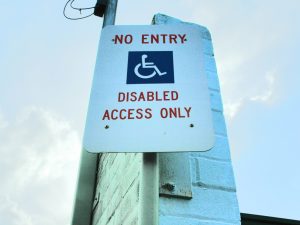Respiratory physician Lutz Beckert considers chronic obstructive pulmonary disease management, including the prevention of COPD, the importance of smoking cessation and pulmonary rehabilitation, and the lifesaving potential of addressing treatable traits. He also discusses the logic of inhaler therapy, moving from single therapy to dual and triple therapy when indicated, as well as other aspects of management
Ritual dump of facts: General election has keyboard in hyperdrive
Ritual dump of facts: General election has keyboard in hyperdrive

Whatever the outcome of polling day next month, public servants will be kept busy polishing their copy for the traditional briefings to the incoming minister, writes Gabrielle Baker
When I was a public servant, the months leading up to an election were punctuated with endless meetings about the “BIM” – that is, the briefing to the incoming minister.
Being empathetic, I’ve been thinking about the task facing public servants in the upcoming election and what I think would make a strong briefing, whatever government we end up with.
Briefings to the incoming minister are provided by government agencies once ministerial portfolios are confirmed, which of course requires the formation of a government. They are usually written before the election, but finessed after the election result is known to account for the known priorities of the new Government. These can include priorities identified in any coalition agreements.
BIMs are meant to give a politically neutral view of the key entities of a sector, major policy issues, recommendations for draft legislation, and recommendations for significant appointments or similar issues that are going to come up in the first six months or so in office.
Despite the effort involved, they can be quite dry, which is perhaps the point, and they are dense and numerous. For example, following the 2020 election there were 15 BIMs for the health sector.
While there might be lots of different BIMs for the health sector and, with new health sector entities Te Whatu Ora and Te Aka Whai Ora, there could be a couple more for good measure this time around, the most crucial one is the overarching health briefing.
The 2020 health briefing talked about:
- the COVID-19 pandemic
- the uniqueness of New Zealand’s health system
- overall health system performance (good for lots of people, but inequitable overall)
- the need for transformation following the Health and Disability System Review Panel’s report and the Waitangi Tribunal’s findings in the first stage of its health kaupapa inquiry (Wai 2575), and
- the seemingly constant pressures on the health system (increasing demand for services, escalating costs of disability support services, workforce shortages, need for capital investment).
There is nothing especially wrong with the 2020 BIM but, with three years and a bunch of health reforms under our belt, new light could now be shed on some of the issues a new minister might face.
The questions of partnership and what this means in a health system…need to evolve as the system matures
Here are the top three things I think a 2023 BIM could cover.
Te Tiriti o Waitangi is foundational for any government activity, so outlining how it operates in the health sector must go beyond reeling off some principles and talking about “equity for all”.
I suggest a departure from government agency practice of describing the Waitangi Tribunal’s articulation of five Treaty principles relevant to primary healthcare (tino rangatiratanga, active protection, equity, options and partnership) and then only giving any meaningful attention to the need for equitable access to healthcare.
The 2020 health briefing, for example, described the five principles then summed it up by talking about being “committed to doing better for Māori and other groups to ensure equity of access to, experience of, and outcomes from care”.
Equity is absolutely important. And achieving equity for “everyone” is a human rights imperative as much as anything. But the reason there are five principles is that equity is not the only feature of a Te Tiriti-compliant health system.
The questions of partnership and what this means in a health system that has established Te Aka Whai Ora, iwi Māori partnership boards, and a Hauora Māori Advisory Committee advising the health minister, need to evolve as the system matures.
Similarly, a new minister needs to understand the principle of options. In simple terms, this principle is about the need for culturally safe mainstream services for Māori as well as appropriately supported kaupapa Māori options.
The minister needs to grasp how the options principle relates to the investment decisions they will inevitably be asked to make. For example, how do kaupapa Māori providers fit into decisions on capital investment?
In describing health issues and system performance, the health BIM needs to remedy the invisibility of disability issues in the previous several BIMs.
I did a search of the 2020 health briefing, and the word disability appears mostly in relation to the term “health and disability sector” – which was always more of a slogan than a reality. There were two more specific references to disability services cost pressures and a note that there was an action plan focused on the needs and aspirations of tāngata whaikaha Māori (Māori with lived experience of disability).
There have been some significant changes in the past three years, and we are starting to see health needs of disabled people be part of the discussion for the health sector (not least of which is the development of an Interim Health of Disabled People Strategy).
But the tentative inclusion in conversations is far from enough, and a strong articulation of the intersecting impacts of ableism and racism for tāngata whaikaha Māori and Pasifika people with lived experience of disability, and impacts for rainbow young people and takatāpui with lived experience of disability, should be essential elements of a fit-for-purpose BIM in the year 2023.
Lastly – if I am to limit myself to three issues – there remain unjust and unfair differences for people in a health system that is so reliant on private, for-profit, health services. As I discussed in my 30 August column, we have always seen this in oral health. But, increasingly, it’s arising in areas that might previously have been considered core publicly funded health services.
I have had multiple conversations in recent weeks with people who are exploring privately funded services or have made claims to ACC because hospital waiting lists are too long for them to endure while they’re in pain.
What do people do, if they cannot afford to pay for a private procedure or health insurance? Normally I’m sceptical about such anecdotal evidence, but it is hard to find accurate figures. The Ministry of Health website has data up until 2018/19 that says there were 240,000 privately funded hospital procedures, up from 210,000 in 2017/18.
But comparing the years as I have done, goes against the ministry’s advice; it points out the years are not comparable mostly because of data issues, as there is a lot of variation between years and not all private hospitals submit their data. On top of data quality issues, 2018/19 data is too old to make useful conclusions on what is happening right now.
It has been difficult to choose just three issues and stick with them. In the interests of brevity, I haven’t even touched on the unglamorous grunt work required to support the new entities to deliver on their promises. (Well, I have now, so I’ve sneaked in a fourth topic – well done, me!)
Anyway, whatever I think should be in a briefing to the incoming health minister, the good news (or bad news) is that it won’t be long before we all get a chance to see what is in the next one.
And when that happens, I am sure we will all agree the more important thing will be seeing government action that recognises the importance of the health system and the necessity of appropriate, equity-driven action that honours the guarantees of Te Tiriti o Waitangi.
Gabrielle Baker (Ngāpuhi, Ngāti Kuri) is an independent health policy consultant







![Barbara Fountain, editor of New Zealand Doctor Rata Aotearoa, and Paul Hutchison, GP and senior medical clinician at Tāmaki Health [Image: Simon Maude]](/sites/default/files/styles/thumbnail_cropped_100/public/2025-03/Barbara%20Fountain%2C%20editor%20of%20New%20Zealand%20Doctor%20Rata%20Aotearoa%2C%20and%20Paul%20Hutchison%2C%20GP%20and%20senior%20medical%20clinician%20at%20T%C4%81maki%20Health%20CR%20Simon%20Maude.jpg?itok=-HbQ1EYA)
![Lori Peters, NP and advanced health improvement practitioner at Mahitahi Hauora, and Jasper Nacilla, NP at The Terrace Medical Centre in Wellington [Image: Simon Maude]](/sites/default/files/styles/thumbnail_cropped_100/public/2025-03/2.%20Lori%20Peters%2C%20NP%20and%20advanced%20HIP%20at%20Mahitahi%20Hauora%2C%20and%20Jasper%20Nacilla%2C%20NP%20at%20The%20Terrace%20Medical%20Centre%20in%20Wellington%20CR%20Simon%20Maude.jpg?itok=sUfbsSF1)
![Ministry of Social Development health and disability coordinator Liz Williams, regional health advisors Mary Mojel and Larah Takarangi, and health and disability coordinators Rebecca Staunton and Myint Than Htut [Image: Simon Maude]](/sites/default/files/styles/thumbnail_cropped_100/public/2025-03/3.%20Ministry%20of%20Social%20Development%27s%20Liz%20Williams%2C%20Mary%20Mojel%2C%20Larah%20Takarangi%2C%20Rebecca%20Staunton%20and%20Myint%20Than%20Htut%20CR%20Simon%20Maude.jpg?itok=9ceOujzC)
![Locum GP Helen Fisher, with Te Kuiti Medical Centre NP Bridget Woodney [Image: Simon Maude]](/sites/default/files/styles/thumbnail_cropped_100/public/2025-03/4.%20Locum%20GP%20Helen%20Fisher%2C%20with%20Te%20Kuiti%20Medical%20Centre%20NP%20Bridget%20Woodney%20CR%20Simon%20Maude.jpg?itok=TJeODetm)
![Ruby Faulkner, GPEP2, with David Small, GPEP3 from The Doctors Greenmeadows in Napier [Image: Simon Maude]](/sites/default/files/styles/thumbnail_cropped_100/public/2025-03/5.%20Ruby%20Faulkner%2C%20GPEP2%2C%20with%20David%20Small%2C%20GPEP3%20from%20The%20Doctors%20Greenmeadows%20in%20Napier%20CR%20Simon%20Maude.jpg?itok=B0u4wsIs)
![Rochelle Langton and Libby Thomas, marketing advisors at the Medical Protection Society [Image: Simon Maude]](/sites/default/files/styles/thumbnail_cropped_100/public/2025-03/6.%20Rochelle%20Langton%20and%20Libby%20Thomas%2C%20marketing%20advisors%20at%20the%20Medical%20Protection%20Society%20CR%20Simon%20Maude.jpg?itok=r52_Cf74)
![Specialist GP Lucy Gibberd, medical advisor at MPS, and Zara Bolam, urgent-care specialist at The Nest Health Centre in Inglewood [Image: Simon Maude]](/sites/default/files/styles/thumbnail_cropped_100/public/2025-03/7.%20Specialist%20GP%20Lucy%20Gibberd%2C%20medical%20advisor%20at%20MPS%2C%20and%20Zara%20Bolam%2C%20urgent-care%20specialist%20at%20The%20Nest%20Health%20Centre%20in%20Inglewood%20CR%20Simon%20Maude.jpg?itok=z8eVoBU3)
![Olivia Blackmore and Trudee Sharp, NPs at Gore Health Centre, and Gaylene Hastie, NP at Queenstown Medical Centre [Image: Simon Maude]](/sites/default/files/styles/thumbnail_cropped_100/public/2025-03/8.%20Olivia%20Blackmore%20and%20Trudee%20Sharp%2C%20NPs%20at%20Gore%20Health%20Centre%2C%20and%20Gaylene%20Hastie%2C%20NP%20at%20Queenstown%20Medical%20Centre%20CR%20Simon%20Maude.jpg?itok=Z6u9d0XH)
![Mary Toloa, specialist GP at Porirua and Union Community Health Service in Wellington, Mara Coler, clinical pharmacist at Tū Ora Compass Health, and Bhavna Mistry, specialist GP at Porirua and Union Community Health Service [Image: Simon Maude]](/sites/default/files/styles/thumbnail_cropped_100/public/2025-03/9.%20Mary%20Toloa%2C%20Porirua%20and%20Union%20Community%20Health%20Service%20in%20Wellington%2C%20Mara%20Coler%2C%20T%C5%AB%20Ora%20Compass%20Health%2C%20and%20Bhavna%20Mistry%2C%20PUCHS%20CR%20Simon%20Maude.jpg?itok=kpChr0cc)